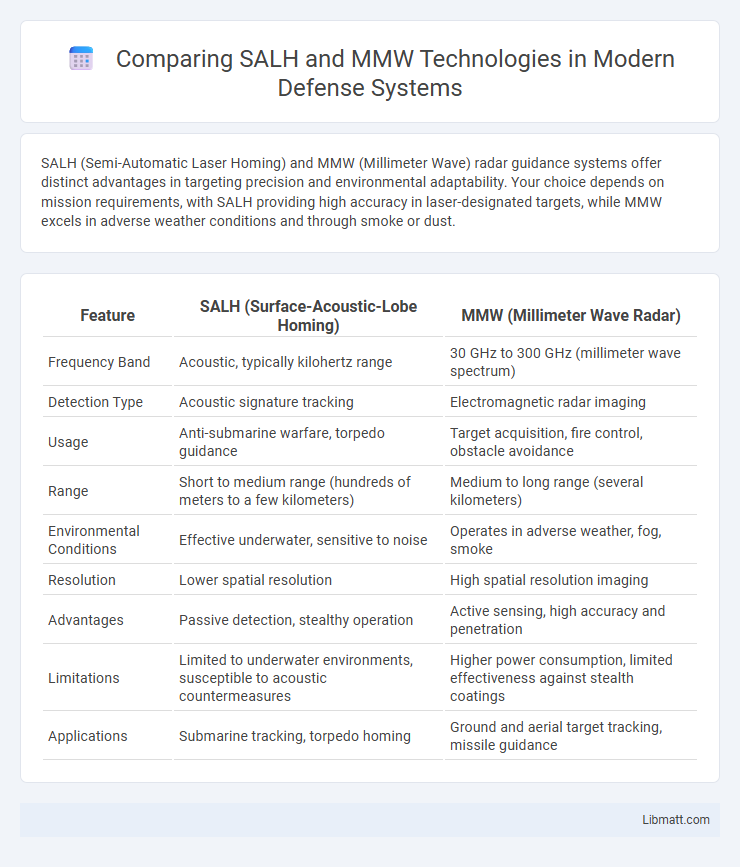SALH (Semi-Automatic Laser Homing) and MMW (Millimeter Wave) radar guidance systems offer distinct advantages in targeting precision and environmental adaptability. Your choice depends on mission requirements, with SALH providing high accuracy in laser-designated targets, while MMW excels in adverse weather conditions and through smoke or dust.
Table of Comparison
| Feature | SALH (Surface-Acoustic-Lobe Homing) | MMW (Millimeter Wave Radar) |
|---|---|---|
| Frequency Band | Acoustic, typically kilohertz range | 30 GHz to 300 GHz (millimeter wave spectrum) |
| Detection Type | Acoustic signature tracking | Electromagnetic radar imaging |
| Usage | Anti-submarine warfare, torpedo guidance | Target acquisition, fire control, obstacle avoidance |
| Range | Short to medium range (hundreds of meters to a few kilometers) | Medium to long range (several kilometers) |
| Environmental Conditions | Effective underwater, sensitive to noise | Operates in adverse weather, fog, smoke |
| Resolution | Lower spatial resolution | High spatial resolution imaging |
| Advantages | Passive detection, stealthy operation | Active sensing, high accuracy and penetration |
| Limitations | Limited to underwater environments, susceptible to acoustic countermeasures | Higher power consumption, limited effectiveness against stealth coatings |
| Applications | Submarine tracking, torpedo homing | Ground and aerial target tracking, missile guidance |
Introduction to SALH and MMW Technologies
SALH (Semi-Active Laser Homing) and MMW (Millimeter Wave) technologies represent advanced guidance and detection systems used in modern military applications. SALH relies on laser energy reflected from a target to guide munitions accurately, providing high precision in targeting while minimizing collateral damage. MMW technology utilizes millimeter wave radar frequencies to detect and track targets through adverse weather conditions, ensuring reliable performance in environments where optical systems like SALH may struggle.
Defining SALH (Semi-Active Laser Homing)
Semi-Active Laser Homing (SALH) is a missile guidance technique that uses reflected laser energy from a designated target to guide the weapon precisely. A laser designator illuminates the target, and the missile's seeker detects the reflected laser light to adjust its flight path. SALH offers high accuracy against stationary or slow-moving targets but requires continuous target illumination until impact.
Understanding MMW (Millimeter Wave) Guidance
Millimeter Wave (MMW) guidance relies on high-frequency electromagnetic waves, typically between 30 GHz and 300 GHz, offering exceptional precision for targeting due to its short wavelength and high resolution. MMW systems excel in adverse weather conditions, penetrating fog, rain, and smoke better than many radar technologies. Your ability to leverage MMW guidance ensures superior accuracy and reliability in dynamic combat environments compared to semi-active laser homing (SALH).
Key Differences Between SALH and MMW
SALH (Semi-Active Laser Homing) and MMW (Millimeter Wave) radar systems differ primarily in their target acquisition methods, with SALH relying on laser reflections for precise targeting and MMW using high-frequency radio waves to penetrate fog, smoke, and dust. SALH offers high accuracy in clear conditions but requires continuous laser designation, whereas MMW provides all-weather capabilities and passive target detection without external guidance. Your choice between SALH and MMW depends on operational environment and mission needs, balancing precision against functionality under various weather conditions.
Advantages of SALH in Modern Warfare
Semi-Active Laser Homing (SALH) provides precise target engagement through reflected laser energy, enabling high accuracy in dynamic combat environments. SALH-guided munitions reduce collateral damage by allowing real-time target designation and continuous guidance, critical for urban warfare and minimizing civilian casualties. Compared to Millimeter Wave (MMW) systems, SALH offers superior resistance to electronic countermeasures and enhanced performance in adverse weather conditions, making it a preferred choice for precision strike missions in modern warfare.
Benefits of MMW Guidance Systems
Millimeter Wave (MMW) guidance systems offer superior accuracy and resolution compared to Semi-active Laser Homing (SALH), enabling precise target tracking even in adverse weather conditions like fog, rain, or dust. MMW systems provide enhanced resistance to countermeasures and electronic jamming, increasing operational reliability and mission success rates. Their ability to operate effectively without line-of-sight restrictions ensures continuous target engagement, making them highly effective for modern battlefield scenarios.
Limitations of SALH vs MMW
SALH (Semi-Active Laser Homing) faces limitations such as vulnerability to weather conditions like fog, rain, and smoke that can scatter or absorb laser signals, reducing targeting accuracy. Unlike MMW (Millimeter Wave) radar, SALH requires continuous line-of-sight laser illumination, making it less effective in obscured or cluttered environments. MMW offers superior penetration ability through adverse weather and battlefield obscurants, providing more reliable target detection and tracking in complex conditions.
Operational Scenarios: When to Use SALH or MMW
SALH is ideal for long-range surveillance and target tracking in open terrain where weather conditions are stable, maximizing detection accuracy and endurance. MMW radar excels in complex urban environments or adverse weather due to its superior penetration capabilities and resolution for close-range engagements. Your mission success depends on selecting SALH for precision at distance and MMW for enhanced performance in cluttered or obscured operational scenarios.
Integration of SALH and MMW in Missiles
The integration of Scanning Array Laser Head (SALH) and Millimeter Wave (MMW) radar technologies in missiles enhances target detection and tracking capabilities by combining high-resolution imaging with all-weather functionality. SALH provides precise targeting through laser guidance, while MMW radar ensures reliable performance in adverse weather and countermeasure environments. This fusion enables advanced missile systems to achieve superior accuracy and resilience against electronic warfare tactics.
Future Trends in Guidance Technology: SALH vs MMW
Future trends in guidance technology highlight the increasing adoption of Synthetic Aperture Laser Homing (SALH) and Millimeter Wave (MMW) radar systems for enhanced target accuracy and resistance to electronic countermeasures. SALH offers superior precision in targeting through high-resolution laser imaging, while MMW technology provides robust performance in adverse weather conditions and through smoke or fog. Integration of SALH and MMW systems is advancing, enabling multi-mode seekers that enhance situational awareness and improve strike effectiveness in complex combat environments.
SALH vs MMW Infographic

 libmatt.com
libmatt.com